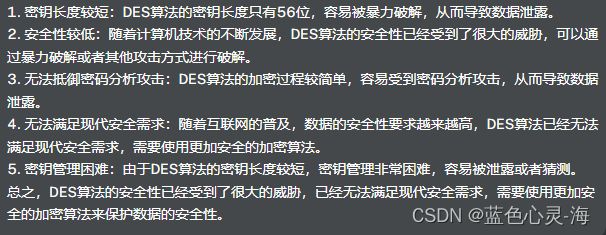对称加密DES加密算法原理、用户登录应用案例分享
更多知识 学习:https://www.processon.com/view/60504b5ff346fb348a93b4fa#map
目录:
- DES算法的工作原理
- DES算法的优点
- DES算法的缺点
- DES算法的应用场景
- DES算法性能分析
- 用户登录实例
- 总结
1. DES算法的工作原理
DES算法是一种对称加密算法,使用相同的密钥进行加密和解密。其基本的加密和解密流程如下:
加密:
- 将明文按照一定的规则进行分组,每个分组的大小为64位。
- 使用密钥生成算法,将密钥扩展为16个子密钥。
- 对每个分组进行16次加密,每次加密包括以下步骤:
a. 将明文分为左右两部分,每部分32位。
b. 将右半部分进行扩展置换,扩展成48位。
c. 将扩展后的右半部分与子密钥进行异或运算。
d. 将异或后的结果进行S盒代替,将48位的结果转换为32位。
e. 将32位的结果进行置换,得到加密后的右半部分。
f. 将加密后的右半部分与左半部分进行异或运算,得到加密后的结果。 - 将加密后的密文输出。
解密:
- 将密文按照一定的规则进行分组,每个分组的大小为64位。
- 使用密钥生成算法,将密钥扩展为16个子密钥。
- 对每个分组进行16次解密,每次解密包括以下步骤:
a. 将密文分为左右两部分,每部分32位。
b. 将右半部分进行扩展置换,扩展成48位。
c. 将扩展后的右半部分与子密钥进行异或运算。
d. 将异或后的结果进行S盒代替,将48位的结果转换为32位。
e. 将32位的结果进行置换,得到解密后的右半部分。
f. 将解密后的右半部分与左半部分进行异或运算,得到解密后的结果。 - 将解密后的明文输出。
DES算法的加密和解密流程都是基于置换、代替和异或运算,通过多轮迭代来实现加密和解密的过程。由于DES算法使用的密钥长度较短,因此存在被暴力破解的风险,需要注意密钥的安全性。
2. DES算法的优点
- 安全性较高:DES算法是一种经典的对称加密算法,其加密强度较高,能够有效地保护数据的安全性。
- 算法公开透明:DES算法是公开的加密算法,其加密和解密的过程都是公开的,可以被广泛使用和分析,从而增强了算法的安全性。
- 加密速度快:DES算法的加密和解密速度较快,适合于对大量数据进行加密和解密。
- 硬件实现方便:DES算法的加密和解密过程可以通过硬件电路来实现,因此可以在硬件设备上快速地进行加密和解密。
- 应用广泛:DES算法被广泛应用于各种领域,包括金融、电子商务、网络安全等领域,是一种非常实用的加密算法。
总之,DES算法是一种安全性高、加密速度快、应用广泛的对称加密算法,具有很多优点,适合于对数据进行保护和加密。
3. DES算法的缺点
- 密钥长度较短:DES算法的密钥长度只有56位,破解难度较大,但仍有被暴力破解的风险。
- 安全性较低:由于DES算法使用的密钥长度较短,因此存在被暴力破解的风险,安全性较低。
4. DES算法的应用场景
- 数据库加密:DES算法可以用于数据库加密,在存储敏感数据时,使用DES算法加密可以有效地保护数据的安全性。
- 金融领域:DES算法可以用于金融领域中的数据加密,如银行卡号、密码等敏感信息的保护。
- 电子邮件加密:DES算法可以用于电子邮件加密,保护邮件内容的安全性,防止邮件被窃取或篡改。
- VPN加密:DES算法可以用于VPN加密,保护网络通信过程中的数据安全性,防止数据被窃取或篡改。
- 移动通信加密:DES算法可以用于移动通信加密,如GSM通信中的数据加密,保护通信内容的安全性。
总之,DES算法可以用于各种需要数据保密的场景中,但是由于DES算法的安全性已经受到了很大的威胁,现在一般不再使用DES算法,而是使用更加安全的加密算法,如AES算法。
5. DES算法性能分析
- 加密速度:DES算法的加密速度较快,适用于大量数据的加密。
- 解密速度:DES算法的解密速度也较快,适用于大量数据的解密。
- 密钥管理:DES算法需要维护密钥的生成、存储和分发,需要注意密钥的安全性。
6. 用户登录实例
- 用户登录过程中,可以使用DES算法对用户密码进行加密,以保护用户密码的安全性。
- 在用户输入密码后,使用DES算法对密码进行加密,并将加密后的密码与数据库中的密码进行比对,以验证用户身份。
好的,下面是一个使用DES加密算法集成Java和Vue开发的用户登录实例:
Java后端代码:
import java.security.Key;
import java.security.SecureRandom;
import javax.crypto.Cipher;
import javax.crypto.KeyGenerator;
public class DESUtil {
private static Key key;
private static String KEY_STR = "myKey";
private static String CHARSETNAME = "UTF-8";
private static String ALGORITHM = "DES";
static {
try {
KeyGenerator generator = KeyGenerator.getInstance(ALGORITHM);
generator.init(new SecureRandom(KEY_STR.getBytes()));
key = generator.generateKey();
generator = null;
} catch (Exception e) {
throw new RuntimeException(e);
}
}
public static String encrypt(String str) {
try {
byte[] bytes = str.getBytes(CHARSETNAME);
Cipher cipher = Cipher.getInstance(ALGORITHM);
cipher.init(Cipher.ENCRYPT_MODE, key);
byte[] doFinal = cipher.doFinal(bytes);
return byte2String(doFinal);
} catch (Exception e) {
throw new RuntimeException(e);
}
}
public static String decrypt(String str) {
try {
byte[] bytes = string2Byte(str);
Cipher cipher = Cipher.getInstance(ALGORITHM);
cipher.init(Cipher.DECRYPT_MODE, key);
byte[] doFinal = cipher.doFinal(bytes);
return new String(doFinal, CHARSETNAME);
} catch (Exception e) {
throw new RuntimeException(e);
}
}
private static String byte2String(byte[] bytes) {
StringBuilder stringBuilder = new StringBuilder();
for (int i = 0; i < bytes.length; i++) {
byte b = bytes[i];
String hex = Integer.toHexString(b & 0xFF);
if (hex.length() == 1) {
hex = "0" + hex;
}
stringBuilder.append(hex.toUpperCase());
}
return stringBuilder.toString();
}
private static byte[] string2Byte(String str) {
byte[] bytes = new byte[str.length() / 2];
for (int i = 0; i < bytes.length; i++) {
String subStr = str.substring(i * 2, i * 2 + 2);
bytes[i] = (byte) Integer.parseInt(subStr, 16);
}
return bytes;
}
}
Vue前端代码:
html
<template>
<div>
<input type="text" v-model="username" placeholder="请输入用户名" />
<input type="password" v-model="password" placeholder="请输入密码" />
<button @click="login">登录</button>
</div>
</template>
<script>
import axios from "axios";
import { encrypt } from "@/utils/des";
export default {
data() {
return {
username: "",
password: "",
};
},
methods: {
login() {
let params = {
username: this.username,
password: encrypt(this.password),
};
axios.post("/api/login", params).then((res) => {
if (res.data.code === 0) {
alert("登录成功");
} else {
alert("登录失败");
}
});
},
},
};
</script>
在Vue中使用了一个名为 encrypt 的函数,该函数通过调用Java后端的 DESUtil.encrypt 方法实现了对密码的加密。需要注意的是,前后端的密钥需要保持一致,这里使用的是 myKey 。
同时,需要在后端的接口中对加密后的密码进行解密,代码如下:
@RequestMapping(value = "/login", method = RequestMethod.POST)
@ResponseBody
public Result login(@RequestBody User user) {
String password = DESUtil.decrypt(user.getPassword());
User loginUser = userService.login(user.getUsername(), password);
if (loginUser != null) {
return Result.success();
} else {
return Result.failure();
}
}
在这个例子中,我们使用DES算法对用户密码进行了加密,确保了用户密码在传输过程中的安全性。同时,我们还需要注意保护密钥的安全性,防止密钥被泄露。
7. 总结
DES算法是一种经典的对称加密算法,它采用相同的密钥来进行加密和解密,具有安全性高、简单易用和适用性广等优点。DES算法的加密过程包括初始置换、16轮加密和末置换三个步骤,解密过程则是加密过程的逆过程。由于DES算法的密钥长度只有56位,因此存在被暴力破解的风险,安全性相对较低。
在实际应用中,需要综合考虑安全性、性能和密钥管理等因素,以确保数据的安全和可靠性。为了提高DES算法的安全性,可以采用多重DES加密方式,即对同一数据进行两次或三次DES加密,使用不同的密钥进行加密,以增加破解难度。此外,还可以采用更长的密钥长度,如3DES算法采用的密钥长度为168位,相比之下,DES算法的密钥长度显得较为脆弱。在实际应用中,还需要对密钥进行安全存储和管理,以防止密钥被泄露或攻击者获取。同时,还需要综合考虑性能和安全性的平衡,选择最适合的加密算法和加密方式,以保障数据的安全和可靠性。
